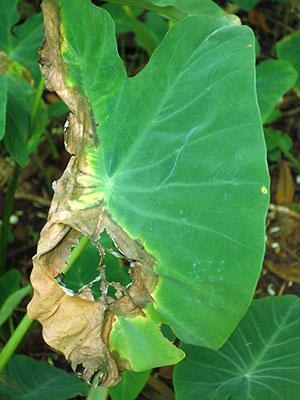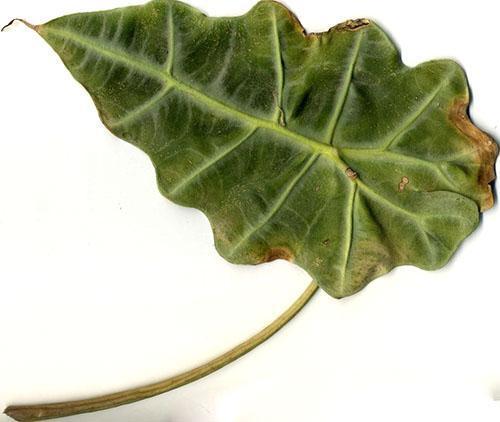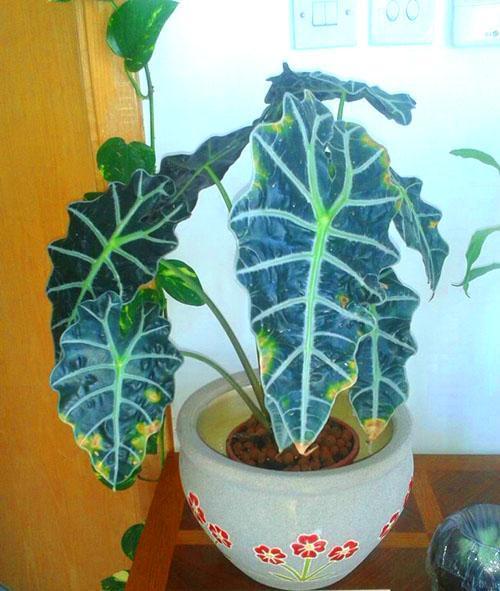The reasons for the appearance of various spots on the leaves of alocasia and how to deal with it
 Numerous types of alocasia, actively grown as indoor plants, attract the attention of flower growers due to their unusual large foliage. Healthy bright leaf plates undoubtedly delight the amateur grower. But what to do if spots appear on a green native of the tropics, the leaves of alocasia turn yellow, dry or completely fall off?
Numerous types of alocasia, actively grown as indoor plants, attract the attention of flower growers due to their unusual large foliage. Healthy bright leaf plates undoubtedly delight the amateur grower. But what to do if spots appear on a green native of the tropics, the leaves of alocasia turn yellow, dry or completely fall off?
The spots that appear on the alocasia, the change in the color of the foliage and its drying out are alarming signals that the plant sends to its owner, talking about ill health and some problems. Most often, flower growers have to deal with the fact that they themselves are to blame for the loss of the attractiveness of the plant:
- The main reason for drying and falling leaves is illiterate or insufficient care of a tropical plant.
- Alocasia diseases requiring urgent treatment are in second place in terms of prevalence.
- And insect pests are a little less dangerous.
Maintenance errors resulting in alocasia stains and loss of foliage

So that the plant does not feel discomfort, and the leaves of alocasia do not turn yellow and do not turn black in the conditions of a city apartment, an atmosphere is organized for the plant that is closest to the natural environment.
While it is not difficult to maintain the temperature in the room within the range of 18–26 ° C, it is rather difficult to create the air humidity necessary for growing alocasia. It is not always possible for flower growers to protect plants from the effects of the cold wind and choose alocasia a convenient place in partial shade.
 Indoor plant lovers who have certain types of tropical crops in their collections often complain that the tips of the leaves dry on alocasia. Sometimes necrosis extends to the entire edge of the leaf plate, and then captures the leaf completely. Such phenomena in most cases are signals:
Indoor plant lovers who have certain types of tropical crops in their collections often complain that the tips of the leaves dry on alocasia. Sometimes necrosis extends to the entire edge of the leaf plate, and then captures the leaf completely. Such phenomena in most cases are signals:
- excessive lighting that burns the sheet plates;
- about unacceptable temperature fluctuations;
- about dry air in the room;
- about a small amount of moisture supplied with irrigation;
- about the root decay that began due to stagnant water.
Having paid attention to the condition of the plant in time, having analyzed the conditions in which it is located, it is possible to accurately determine the cause of the drying or yellowing leaves of alocasia.
So, for example, drying out of the edges of the leaf and the appearance of brown spots may indicate too dry air in the room. When it is possible to bring the humidity to the required 60–65%, the spread of stains stops, and the tips of the leaves of alocasia do not dry out. Similar symptoms can be seen if the plant is in direct sunlight or near heating appliances. But the flow of cold air sometimes causes the spread of dark brown or black spots on the leaf plate.
 Sometimes, with discomfort, alocasia sheds all the leaves. If the florist notices this behavior of the plant, he should pay attention to the condition of the root system and the aerial part of the alocasia.
Sometimes, with discomfort, alocasia sheds all the leaves. If the florist notices this behavior of the plant, he should pay attention to the condition of the root system and the aerial part of the alocasia.
This reaction is possible in two situations:
- if necessary, transplanting a rapidly growing plant;
- on the eve of flowering.
 In the first case, a larger pot is selected for the plant and transferred to a new substrate, and in the second, it is better to relieve a very emaciated alocasia from the additional load and cut out the peduncle that has appeared, without waiting for flowering.
In the first case, a larger pot is selected for the plant and transferred to a new substrate, and in the second, it is better to relieve a very emaciated alocasia from the additional load and cut out the peduncle that has appeared, without waiting for flowering.
Interestingly, alocasia can react in a similar way to the imbalanced mineral composition of the soil.
- If it is poor in nutrients, the grower will notice how the tips of the leaves dry on alocasia.
- With a lack nitrogen growth slows down, the lower leaves of alocasia turn yellow and wither.
- Unreasonably frequent feeding causes increased foliage growth, although its shape may differ from healthy.
If you do not take measures in time and do not take care of the flower, alocasia becomes an easy prey for pests and pathogens.
Diseases of alocasia and their treatment
 The composition of the soil and its moisture have a great influence on the health of the plant. If the soil mixture is too dense, accumulates a lot of moisture, you can expect that this will affect the root system of the tropical inhabitant and the quality of its foliage.
The composition of the soil and its moisture have a great influence on the health of the plant. If the soil mixture is too dense, accumulates a lot of moisture, you can expect that this will affect the root system of the tropical inhabitant and the quality of its foliage.
Root and stem rot are the most common diseases of alocasia, and the treatment of diseases caused by bacteria, viruses and fungi must be carried out systematically and immediately.
Fusarium and late blight on alocasia plants appear externally in the form of brown putrefactive spots on the leaf petioles closer to the base, then the disease spreads to the leaf blades. Tissues change color, soften and die off.
 When such spots are detected on alocasia, all damaged parts of the plant are removed, be sure to check the condition of the roots, where the focus of the disease lies. The cut sites are cleaned to healthy tissue and treated with charcoal powder. The rest of the trunk is wrapped in wet sphagnum moss and placed in a container under a film. In such greenhouse conditions, with regular moistening, alocasia will be able to give new roots and prepare for planting in the ground.
When such spots are detected on alocasia, all damaged parts of the plant are removed, be sure to check the condition of the roots, where the focus of the disease lies. The cut sites are cleaned to healthy tissue and treated with charcoal powder. The rest of the trunk is wrapped in wet sphagnum moss and placed in a container under a film. In such greenhouse conditions, with regular moistening, alocasia will be able to give new roots and prepare for planting in the ground.
The soil mixture should be disinfected, since putrefactive bacteria can be in the soil for a long time, and a weakened plant is the main target for them.
When anthracnose infection Alocasia leaves appear brown spots with a yellowish halo. As the disease progresses, the spots on alocasia expand, and concentric circles of a dark shade become visible on the affected tissue.
 The formation of yellow and black spots on the leaves of alocasia can also mean infection with powdery mildew. For all such diseases, the plants are carefully treated with fungicides, and they are also properly cared for.
The formation of yellow and black spots on the leaves of alocasia can also mean infection with powdery mildew. For all such diseases, the plants are carefully treated with fungicides, and they are also properly cared for.
As a preventive measure, it is worth regularly removing drying leaves and not leaving fallen plant residues on the soil.
It is they who are able to become a haven for pathogens, the treatment of alocasia from which will require a lot of time and effort.
Alocasia pests
 Harmful insects on alocasia come from infected neighboring plants or from the soil. Often undetected enemies enter the house along with a flower from a flower shop.
Harmful insects on alocasia come from infected neighboring plants or from the soil. Often undetected enemies enter the house along with a flower from a flower shop.
Juice-eating insects and worms weaken the plant. As a result, the leaves of alocasia turn yellow, their tips begin to dry out, and then the process develops and affects the entire surface of the leaf plates. Without proper attention and urgent measures, alocasia sheds all the leaves and may die.
Aphids and scale insects can be dealt with with home remedies, these pests are easily detected and just as easily destroyed.
The main danger for indoor alocasia species is mealybugs, nematodes, aphids and spider mites.
The destruction of these pests is carried out in several stages with the help of insecticides, with which both the aerial part of the plant and the soil lump are treated. If alocasia has suffered from nematodes, it is better to get rid of such a specimen, since even with vegetative propagation of the plant, there is a possibility of spreading a dangerous infection.
Hello! I bought alocasia in the store with one leaf, which was covered in yellow spots. At home, I transplanted it, separated one nodule, cut off a leaf, now when a new leaf is trying to appear, there is a black dot on it, at the very top. What is it and how to fix it so that it grows into a full-fledged sheet. Thank you in advance.
Without a photo, it is difficult to pinpoint the exact reason. Yellow spots on alocasia can indicate both an excess of light and necrotic disease or the appearance of ticks. Black spots are the result of either a fungal disease in the form of root rot, or too dry air.
Hello.
Problem: Leaf turned yellow.
The reason is not known. I take care of and follow all the rules for the care of alocasia.
I have had alocasia flower for a long time already, it bloomed and gave new leaves, BUT the yellowing of the leaves was not when there was not.
Question: How to remove an unhealthy leaf so as not to damage the whole flower? And is it possible, after cutting the sheet, to process it with crushed coal or in another way?
There can be many reasons, from excess moisture to illness. Outwardly, the rest of the leaves seem to look good. Try treating the flower with a fungicide for prevention. And just cut the yellowed leaf with a sharp knife as low as possible. The cut can and should be sprinkled; crushed coal is fine.
Thank you so much!
Good day! Can I send you a photo of alocasia? To understand what's wrong with her. I read a lot of articles, but not quite that. The leaves are covered with yellow spots, then completely turn yellow, but at the same time wet! Do not dry!
I will be very grateful for the answer!
Yes, of course, send a photo of your plant. We will try to help you.
Hello! I took an already adult plant from a friend, there were five leaves, sat in a small pot, transplanted and spots began to appear on the leaves. At first, just specks, then they dried up. I decided to touch one of these and in the end the leaf just tore ... I had already cut one leaf, but with the remaining four the same trouble. Please help me understand what it is and how to fight. I treated it with soapy water and phytoverm. So far, the result is zero.
It doesn't have to be a disease. I do not have such a flower, but those who grow it often notice exactly this reaction of alocasia to transplantation. After this procedure, it adapts for a long time and is very difficult, and the old leaves are just covered with spots drying into a dry net. Everything may even be lost if there were few of them. You can help the bush take root faster by treating it with Epin.
In addition, such spots also occur in the case of excess moisture in the soil. If the new pot is large for your bush, the soil in it remains wet for a long time. With frequent watering, the roots begin to rot, which means that the leaves also disappear. And, paradoxically, the plates also dry out if the air in the room is dry, because alocasia need high humidity.
Check the condition of the soil. If it is waterlogged, there is nothing to be done; you will have to examine the roots. Find rotten ones - cut, treat with fungicide. If the soil from the pot is in good condition and has time to dry out between waterings, just try to spray the bush more often. You can put it on a pallet with damp pebbles.